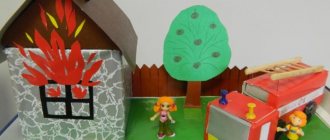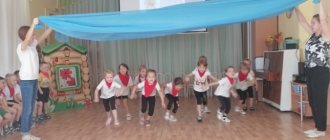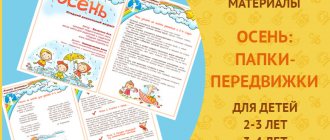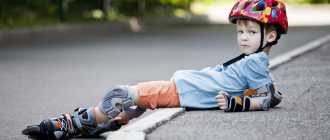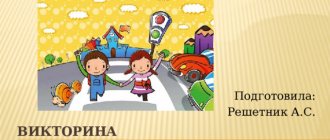Road safety for children
You should not rely on the fact that after looking at a colorful poster on the topic of road safety, your child will learn everything and behave correctly. How, then, can we teach children these important fundamentals? A systematic, comprehensive approach is needed. Parents and teachers should unobtrusively and constantly tell what not to do and explain what violations of the rules can lead to. Don’t forget about your own example of how to follow traffic rules.
Methods of teaching children safe road traffic
To make it easier for your child to learn the basics of road safety, use a variety of methods. This will help you learn the skill of safe behavior more effectively.
- About the explanatory and illustrative method Talk with your child, read books with stories about the rules of behavior on the street and the road, study road signs, look at posters, play educational games and watch educational cartoons together.
- Practical method When outside, draw children's attention to the road, signs, cars and other pedestrians. Simulate driving situations at home using toys.
- Artistic method Coloring, crafts, drawings, applications on this topic help to consolidate the acquired knowledge.
- Game method Role-playing games are a great way to apply acquired knowledge and try yourself in different roles. Create situations in the game that can happen in reality: for example, play as a passenger and a bus driver, as a pedestrian and as a taxi driver.
Tasks:
- Educational:
repeat and consolidate children’s knowledge about the rules of safe behavior in the house, on a pond, while swimming; find out what dangers may lie in wait when communicating with strangers; broaden children's horizons. - Developmental:
develop cognitive activity, develop the ability to work together, conduct dialogue, thus developing the communication abilities of students; improve mental operations of analysis, generalization, comparison; develop mental processes: memory, thinking, imagination, attention, emotions; the ability to critically evaluate the work of classmates; develop in children a sense of confidence in their abilities. - Educational:
to cultivate a sense of responsibility for actions taken, curiosity and inquisitiveness in the learning process.
- Equipment:
posters depicting dangers in the home and in case of fire; multimedia projector, computer, screen, pictures with mushrooms, berries, sheets with test work. - Forms of work:
frontal, work in pairs, individual. - Methods:
conversation, game methods, generalization, analysis. - During the classes.
- Organizing time.
Hello.
We have guests in class today, say hello, sit down and we won’t be distracted anymore. Today we will all work together and to make us feel comfortable, we will tell each other our names in a circle. Today in class we will talk about our safety. A game will help us with this, but not an ordinary game, but a computer one. We will remember what dangers await us at home, in the forest, on the pond. Let's find out what other dangers there are.
Cartoon characters will help us with this. So, our game begins.
Level 1 of the game is called "Home Hazards".
— What dangers could there be in the house?
Our heroes are left alone at home. Each of them took several items for themselves. But they don't know what danger each thing poses. Let us help you avoid trouble.
(Children's answers)
(O. Medvedeva) (slides)
Mom went to the store, Bimka was at home alone. The phone rang - The puppy lost all sleep! - Hello, hello! Who's speaking? Where is dad? He's standing here. No, he's busy, sorry, call me a little later! Well done, you have completed the 1st level of the game.
The door to the 2nd level is open for us.
But to find out what it’s called, you need to guess what Chukovsky’s poem “Confusion”
. And Andrey Ivanov will read it to us.
- The sea is on fire,
- A whale ran out of the sea:
- “Hey firefighters, run!
Help! Help!"
—What danger are we talking about in these verses? How to protect yourself from it?
Our heroes wanted to compile a memo for you, but they got everything mixed up in it.
You need to fix all the mistakes. Pictures on the board.
“So that there is no fire.”
- Always and everywhere play with matches and lighters.
- Light the gas stove yourself, and do not try to light the stove in a rural house.
- Leave the iron or kettle on unattended.
- Play with gasoline, kerosene and other liquids that may catch fire.
- Light a fire in the forest without adults.
We have moved to the third level of the game. But we'll play a little later.
Exercise for the eyes.
Let's take a walk in the forest. Stand up please.
Be careful! If I name objects that can be dangerous in the house, then look up, then down; If I name objects that contribute to a fire, then the eyes - left and right.
But I have set traps, if I name objects related to other dangers, then close your eyes tightly. Knife, matches, iron, car, balcony, gasoline, traffic light.
Well done, you completed the task. Take your seats.
- — While we were resting, our heroes moved to level 3.
- Level 3 – “Forest dangers”.
- — What can be dangerous in the forest?
Our heroes are about to go into the forest, and you are invited to go with them. But so that you can be with them, they decided to test how well you know edible mushrooms and berries.
There are pictures of mushrooms and berries on your tables. You need to collect edible mushrooms and berries in a basket, and put the poisonous ones aside.
(Examination)
Look, some insects are approaching them. Are they dangerous to humans? How?
Pictures on the board.
Level 4 – “How should you bathe?”
The heroes ran from the insects and ended up near the river. It was a very hot day and they decided to swim. Let's tell them how to behave on a pond so that trouble doesn't happen.
(Children's answers)
Open water is always a risk. And we need to make sure that this risk is minimal. First, read the rules of behavior on the beach where you are going to relax - they are usually posted in a visible place. Please note the restricted swimming areas and signs warning of hazardous areas. Try not to swim in unfamiliar places, especially alone.
Now some tips:
- Don't dive in unfamiliar places;
- Don't swim behind the buoys;
- Do not swim far on inflatable mattresses, toys, inner tubes;
- Don't play games with grabs on the water;
- Do not sail far from the shore and do not swim across a body of water for a dare;
- Do not swim where there are ships, and do not get close to them, as you may be pulled under the engine's propellers.
Level 5 – “This suspicious guy...”
Our heroes need to return home. Let's go with them.
- Physical education minute.
- Along the path, along the path, we jump on our right leg.
- And we jump along the same path on our left leg.
- They ran along the path and reached the lawn.
- On the lawn, on the lawn we'll jump like bunnies.
Stop. Let's rest a little and go home on foot.
— we walked and, unnoticed by ourselves, moved to level 5. Who do you think this suspicious guy is...
We remembered how to behave at home, in the forest, on a pond, so that trouble does not happen. But we do not live on an inhabited island, but in a city where we are surrounded by many different people. Unfortunately, not all people wish us well. Therefore, you need to know how to behave in various situations with strangers. And Seryozha Kuznetsov will read a poem to us.
Mom knows all my secrets, and always helps me with everything. If something happens suddenly, Mom is the most faithful friend. They often treat us, Just remember every time: Take treats only from friends, and not from strangers who seem modest and kind.
- What is this poem talking about?
- (Children's answers)
- That's right, about strangers.
- You need to know a few safety rules in case you meet a suspicious stranger.
Rule 1.
It is better to walk down the street in the company of friends. Attackers prefer to deal with children who wander alone. Immediately move away from the edge of the sidewalk if a car slows down next to you or is driving slowly behind you. The driver can say anything to you, urging you to come closer. Ignore this and stay 3-4 meters away from the car.
Rule 2
. Never agree to go with a stranger if he asks for it. The stranger can be either a woman or a peer. Always tell your family or friends where you are going and with whom. Well, if someone grabs you and pulls you along, break free, kick the offender, bite. And most importantly, scream.
For example, “Leave me alone!” I do not know you! Or you are not my father! You want to kidnap me!
It is precisely such phrases that can more likely attract the attention of passers-by than simply shouting “Help!” The main thing is to make it immediately clear that this is not a family quarrel, that this person is a complete stranger to you, that you are being taken somewhere against your will.
Rule 3
. If an unfamiliar adult approached you on the street and suddenly started talking to you for no reason. This is not entirely common.
And it’s really strange if he asks for help with something, for example, to look for a lost kitten together, go to a cafe, or play a computer game.
Remember: adults should seek help from adults, not children. Of course, the safest thing is not to engage in conversation with a stranger at all.
- Rule 4.
- Check the reliability of locks and latches;
- Never open the door to a stranger, no matter what reasons he gives or who he introduces himself to be;
If the doorbell rings, you must first look through the door peephole, standing to the left of the door and ask “who?”, Do not open it until you are sure that a person you know well has arrived.
Level 6. This is the final level of our game. If you pass it successfully, then you will win today's lesson.
- The characters are very pleased with you and want to check how you have mastered the material.
- — They invite you to do a little “test yourself” activity.
- ( Color the pictures where Katya does the right thing, independently completing the task, mutual checking). (slides)
- Our game ends. The heroes want you to remember the rule of the four “Don’ts,” which police officers in many countries specially invented for children.
- Never talk to a stranger.
- Never get into a stranger's car.
- Don't play on the way home from school.
- Don't play after dark.

